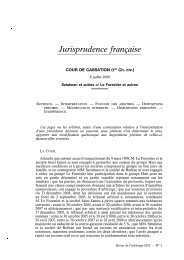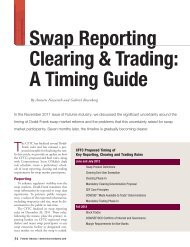What is a Broker-Dealer? - Davis Polk & Wardwell
What is a Broker-Dealer? - Davis Polk & Wardwell
What is a Broker-Dealer? - Davis Polk & Wardwell
Create successful ePaper yourself
Turn your PDF publications into a flip-book with our unique Google optimized e-Paper software.
<strong>What</strong> Is a <strong>Broker</strong>-<strong>Dealer</strong>? § 1A:4.3<br />
encompasses instruments with widely varying character<strong>is</strong>tics, depending<br />
on whether <strong>is</strong>sued in consumer context or in some other investment<br />
context. 269 The U.S. Supreme Court, in Reves v. Ernst & Young,<br />
has adopted a specialized test—the “family resemblance” test—to<br />
determine whether a “note” <strong>is</strong> a security. 270 Whether a given note <strong>is</strong><br />
or <strong>is</strong> not a “security” <strong>is</strong> a matter that requires specific analys<strong>is</strong>.<br />
Under the “family resemblance” test, courts presume that every<br />
“note” <strong>is</strong> a “security.” 271 Th<strong>is</strong> presumption may be rebutted only by a<br />
showing that the note bears a strong resemblance to one of the<br />
enumerated categories of instrument on a judicially developed l<strong>is</strong>t of<br />
exceptions from the rule. 272 If an instrument <strong>is</strong> not sufficiently similar<br />
to an item on the l<strong>is</strong>t, courts will decide whether another category<br />
should be added to the l<strong>is</strong>t. 273<br />
The Supreme Court in Reves adopted the l<strong>is</strong>t created by the Second<br />
Circuit. 274 The Second Circuit’s l<strong>is</strong>t includes instruments commonly<br />
denominated “notes” that nonetheless fall outside of the “security”<br />
category, such as:<br />
(i) a note delivered in consumer financing;<br />
(ii) a note secured by a mortgage on a home;<br />
(iii) a short-term note secured by a lien on a small business or<br />
some of its assets;<br />
(iv) a note evidencing a character loan to a bank customer;<br />
(v) a short-term note secured by an assignment of accounts<br />
receivable;<br />
(vi) a note which simply formalizes an open-account debt incurred<br />
in the ordinary course of business (particularly if, as in the case<br />
of the customer of a broker, it <strong>is</strong> collateralized); and<br />
securities laws apply. Th<strong>is</strong> would clearly be the case when the underlying<br />
transaction embodies some of the significant character<strong>is</strong>tics typically<br />
associated with the named instrument. See United Hous. Found., 421<br />
U.S. 850.<br />
269. See Landreth Timber Co. v. Landreth et al., 471 U.S. 681, 694 (1985). An<br />
investor cannot justifiably assume that a sale of a note <strong>is</strong> covered by the<br />
securities laws, because not all notes involve investments. See Reves, 494<br />
U.S. 56.<br />
270. Reves, 494 U.S. 56.<br />
271. Id.<br />
272. Id. If an instrument bearing the name “note” does not meet the family<br />
resemblance test, it can still be security if it meets the Howey test and falls<br />
under the category of “investment contract.”<br />
273. Id.<br />
274. Reves, 494 U.S. 56.<br />
(<strong>Broker</strong>-<strong>Dealer</strong> Reg., Rel. #9, 9/10)<br />
1A–61





